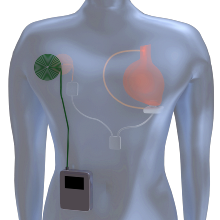The worldwide increase in cardiac insufficiency with a simultaneously stagnating number of available donor organs is increasingly being counteracted by mechanical circulatory support systems. These can bridge the waiting time until a suitable donor heart is available but can also be used as so-called "destination therapy".
The system's state-of-the-art power supply via a drive-line cable through the abdominal wall is associated with reduced patient comfort and also represents a high risk of life-threatening infections ("drive-line" infections).
By means of an inductive energy supply, the secondary-side energy transmission system can be completely implanted, thus eliminating the disadvantages of current systems mentioned above.
The depiction on the right displays the schematic structure of an inductive energy transfer system for mechanical cardiac support systems implanted in the body. By using suitable compensation arrangements and electronic topologies, very high efficiencies can be achieved in order to minimize the warming of the tissue structure in a patient's body. With additional implantable batteries, temporary independence from the primary-side energy transmission system can also be achieved, allowing patients to regain many of the freedoms of a normal life.
The main research areas of this application require interdisciplinary cooperation between medical, medical technology, and electrical engineering institutions. These efforts are concentrated on the design of an electromagnetic transmission system, whereby efficiency optimizations and the realization of an extremely fail-safe system are research focal points. On the other hand, the existing know-how must be adapted to applications in medical technology which place special demands on the selection of biocompatible materials.



